Swing Plane Path And Other Considerations Part 1
- by Kelvin Miyahira
If Dr. Sheldon Cooper of the Big Bang Theory were a golf scientist, this is what he’d say to a planeologist. “Yes - it tells us that you participate in the mass golf cultural delusion that the club's apparent position relative to an arbitrarily defined line scribed on a 2D monitor in the middle of your downswing somehow affects your club’s path at impact and your ability to hit a perfectly straight shot.”
Planeologists also tell you that by getting the club “on plane” you automatically will have the bottom of the swing arc in the correct place so that you can hit it cleanly with a downward blow on your iron shots as well as hit up on the ball with your driver. The perfect plane is really a happy place where all the magic will suddenly appear. Golf shots will fly far and straight as an arrow because squaring the club is easier from the correct plane. Better still there will be lots of ice cold Budweiser beer, girls golfing in bikinis and white sandy beaches. Sounds like a dream? It is.
There are so many questionable assumptions being made about the plane so let’s take a look at just a few of them this month. Let’s start with swinging on the shaft plane.
Swing on the “Original Shaft Plane”
Yes, we’ve seen this line drawn thousands of times before. Draw a line through the shaft at address and that’s supposedly the “plane” to swing on.

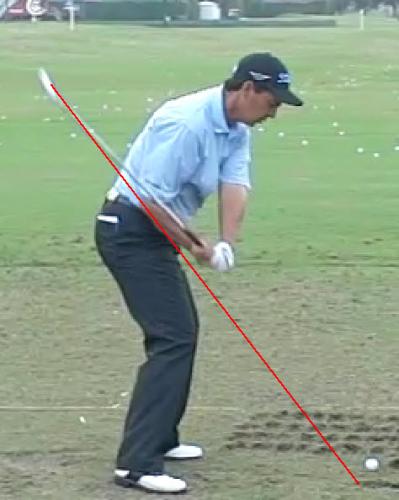

But did Tom return to impact perfectly on the shaft plane line like a good planeologist should? Thus, even when trying, it’s pretty difficult to do.

Zach Johnson

Hunter Mahan
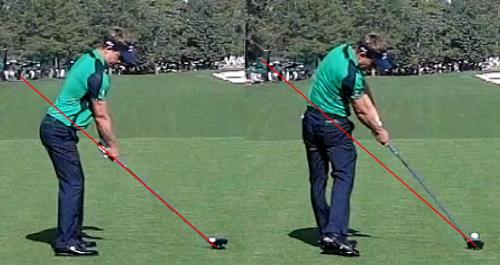
Luke Donald
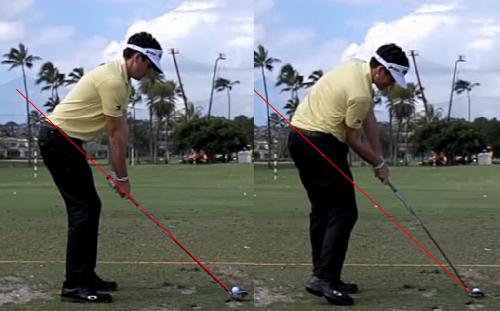
Keegan Bradley
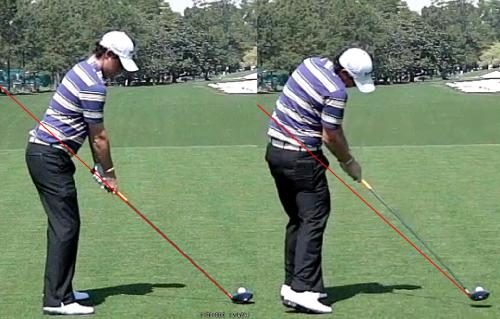
Rory McIlroy
Doesn’t ulnar deviation cause the hands to rise a bit? Therefore returning to a shaft plane at address is going to be nearly impossible. Thus, most pros do not swing the club on the “original shaft plane” nor do they return the club onto the original shaft plane line at impact. Realize that doing so requires eliminating UD from your swing and this will de-stabilize your impact position (increase likelihood of flip).
Copying Hogan
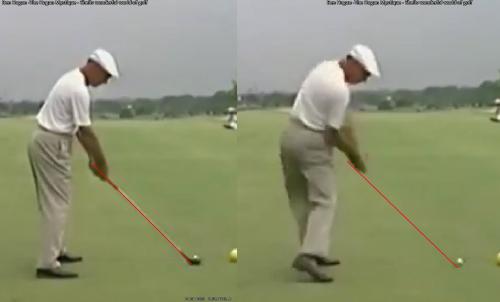
Even the great Ben Hogan didn’t quite return perfectly to the original shaft plane. At impact, his hands are slightly above where it was at address. Many try to imitate Hogan’s plane without his tremendous body rotation or drive/hold release pattern. What good is that?
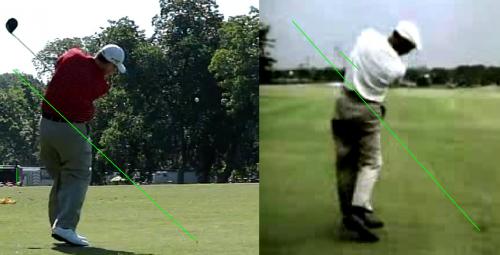
Announcers like to say Chad Campbell’s swing looks just like Hogan. Look at his shaft exiting on the flat, low angle just like Hogan. Some would call that an in-to-in swing.

But from the front view, Chad looks nothing like Hogan. What good is a great plane if your release looks like this? His left wrist might be bowed but the clubhead has already passed his left forearm. That might be best called the flip’n drive release. Don’t think Hogan did that...
And body rotation? Not even close.
Thus, there is so much more going on in the great swing of Hogan that you can’t just copy his plane (people are in love with target line view only) and expect the results of Hogan. How about copying his swing from front view?
What’s a Flat or Steep Plane?
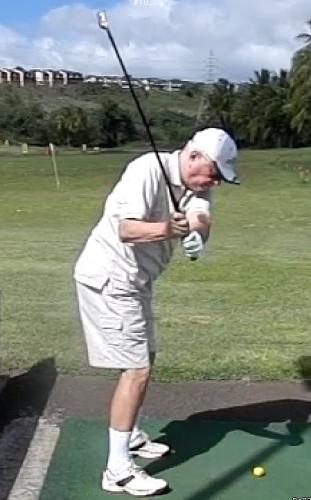
This is a steep downswing of an over the topper.

And this is Steve Marino. What’s the difference between the two? Perhaps the plane isn’t the only thing to be looking at? How about right shoulder internal or external rotation? Elbow movement is critical here. The OTT swinger has already fired his right shoulder internally. Also he isn’t using his lower body much at all whereas Marino has his hips open a little and has some lateral bend (see right shoulder tilted down more?).
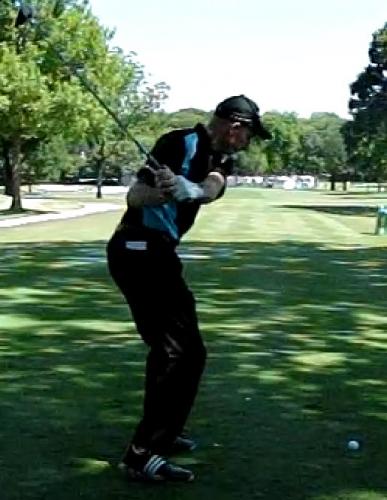
Here’s Jim Furyk, one of the straightest hitters on tour. On plane?
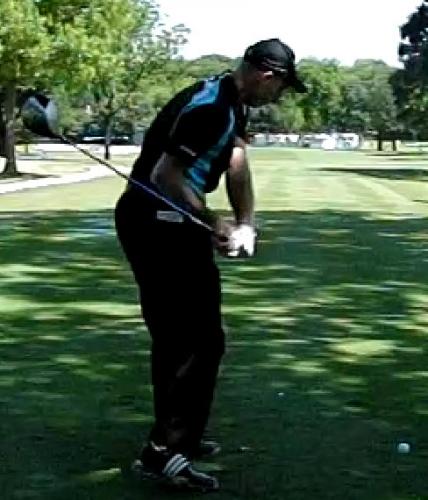
What about here? His right elbow is behind his body and now his club looks way too flat. But other than that, look at his left wrist. It’s already a little bowed or in flexion. This closes the clubface earlier so he can be more stable with his hands at impact. See video below.
Also, Jim’s body is rotating very well. He’s cleared out his hips already.
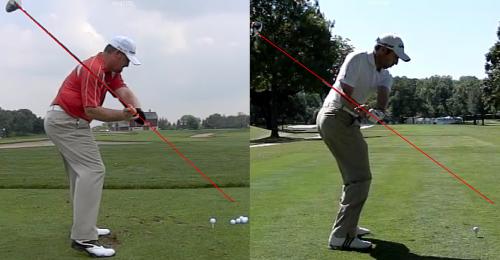
Next, here’s JB Holmes and Sergio Garcia. Both have the shaft in a flat position where the shaft is pointing above the ball instead of directly at the ball. Does this mean they both have flat swings?

Perhaps by drawing the original shaft line it can help planeologists see the differences. Now we see that JB is parallel to the plane. Hmmmm, Haney would approve? Meanwhile Sergio has his club under the plane. Look carefully, his club is almost lost in the dark background of the trees.
But let’s look at more important things. JB has rotated his body more whereas Sergio has kept his chest pointed away from the target. Notice the left arm position of JB which is way more in front than Sergio’s. JB’s right elbow is in front of his right hip while Sergio’s is stuck behind.
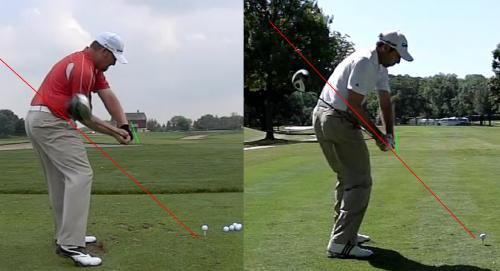
Now what are we to call JB’s plane? His club is actually behind his hands and therefore flat, yet his club/arms are above the original shaft plane. Sergio’s club is under the plane so we can call that “flat” correct?
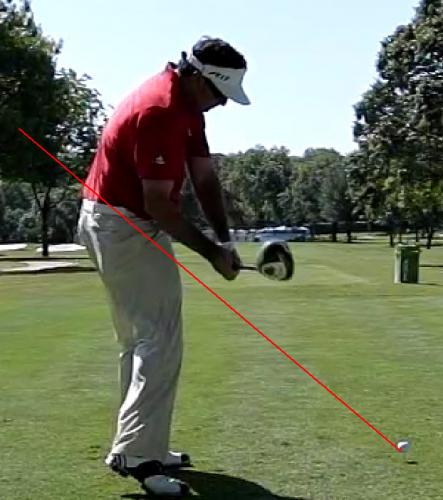
To help with labeling JB’s position, here’s Pat Perez with his club a bit in front of his hands. This would make JB’s position flat correct?
So there are a lot of grey areas when describing a steep or flat plane. And most of the pros’ planes/positions are ever-changing. They might be steep in some areas while being flat in other areas.
Without looking at body rotation, arm/hand/wrist positions relative to club position and even desired shot type, all of this labeling might be an exercise in futility.
Swing Plane and Path
What about the relationship of swing plane and club path? Conventional golf wisdom leads us to believe that if you are on the perfect plane then your swing path will be straight at the target at impact. Also, a flat swing will produce a path that’s moving to the right at impact and a steep path will have a path moving to the left. Let’s see how this plays out in the real world.
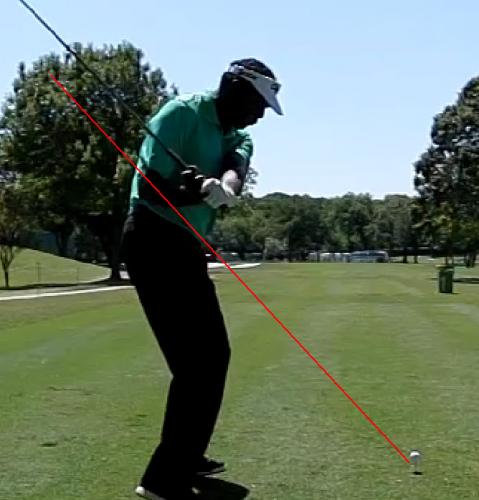

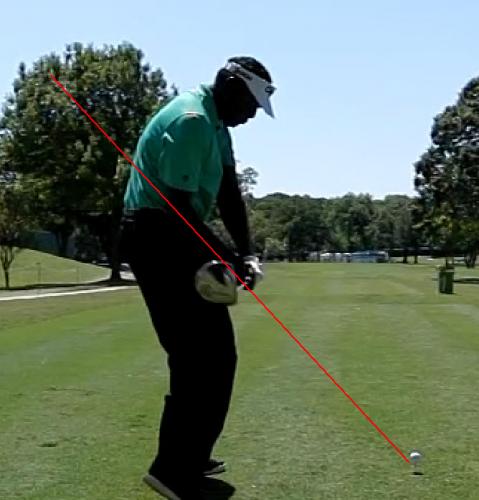
Here’s Vijay Singh swinging on the perfect plane.
But where is his path going?
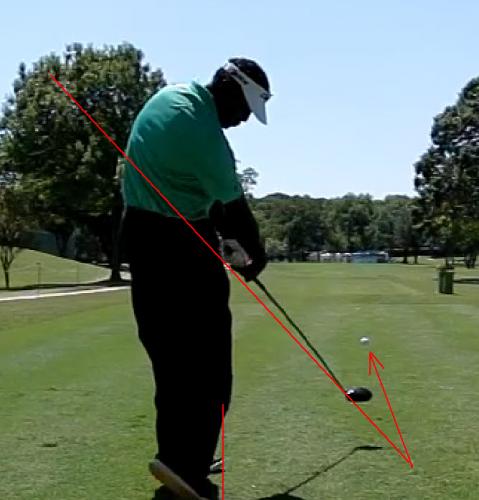
This is Vijay’s intent since he does not want to hit anything but a fade. So what did his plane have to do with his path?
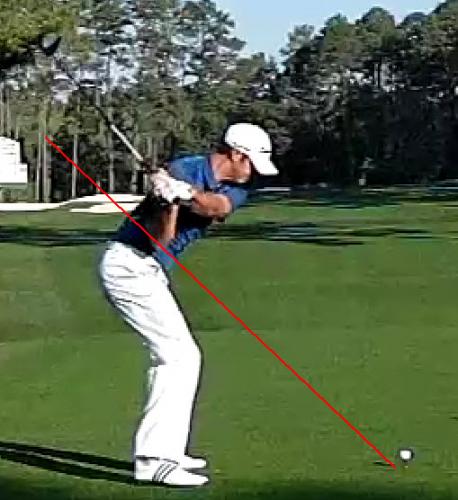
Here’s Dustin Johnson with a pretty good looking plane. Yet his club is not anywhere near the original shaft plane like Vijay’s (it’s steeper? Who cares).
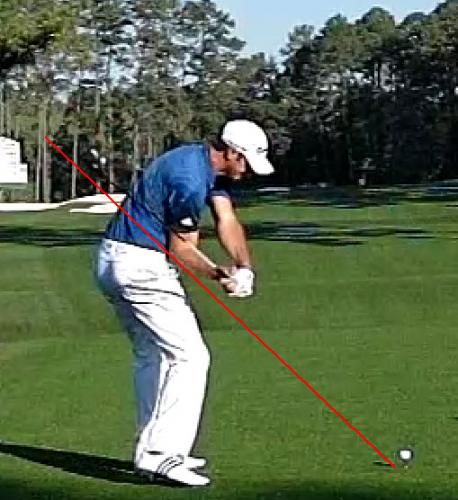
Here it looks closer to the perfect plane.
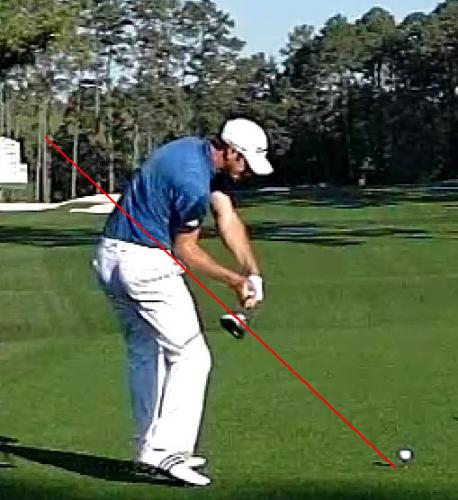
Great here.
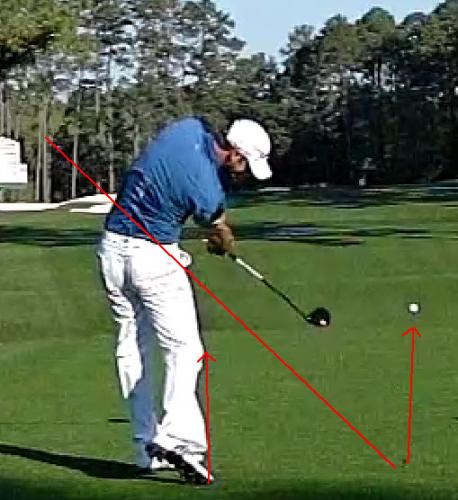
But you can clearly see his path is headed to the right.

Given Brandt Snedeker’s perfect plane on the downswing, would you say his path at impact would be:
- Straight at target
- Slightly right of target
- Slightly left of target

Need more information?
Given this position, is it becoming clearer?
- Straight at target
- Slightly right of target
- Slightly left of target

How about this one? Dead giveaway.
- Straight at target
- Slightly right of target
- Slightly left of target
Before looking at the answer, what’s your guess?



The answer is actually “c” slightly left of the target or since you didn’t have all the information needed, I should have added another choice, “d” cannot be determined. Just because the club looks to be on a flat or slightly under the plane in a 2D world, it doesn’t necessarily mean that your path will be straight or slightly to the right at impact. Three dimensionally, the path can change due to widening the swing arc prior to impact. And in this case, it occurs only one frame before impact yet radically changes the club’s path. Thus, the path of Brandt Snedeker’s club is actually moving slightly left of target at impact.
How does this happen?


In order to understand this, you need to have two views at the same time to get a “3D” image of what’s going on. As you can see, Snedeker has a good amount of lag. But his right elbow is slowing down and his right shoulder is moving to internally rotate vs. Dustin Johnson has his right shoulder in external rotation while his elbow is still driving toward the target.

Plane looks great, but from the front view can you see that his right arm is straightening and right wrist moving to flexion.


See the right wrist and right arm differences? DJ has his right wrist more cupped or extended. How about the body rotation differences? Not difficult to see how much more rotated Dustin is vs. the stalling Snedeker.

One frame after impact, Brandt has underflipped it. Along with his club path that’s moving left, this creates a nice soft fade. This is a very good accuracy swing. But we also know that Brandt is 120th in driving distance with an average of 284.5 yards per drive.
Ready for another test?

Here’s Mark Wilson. Where is his path going?
- Straight at target
- Slightly right of target
- Slightly left of target

Just a little under the plane. Dead giveaway.
- Straight at target
- Slightly right of target
- Slightly left of target

- Straight at target
- Slightly right of target
- Slightly left of target
The answer is?



Once again, the early right shoulder internal rotation triggers early right arm extension and right wrist flexion creating the widest point in his swing arc to be just prior to impact. This takes the swing path and has it moving slightly from out-to-in or slightly to the left of his target. So the correct answer is... ”c” slightly left of target.
Not that there’s anything wrong with that since there are many on tour swinging like this. Just have to remember that the rules for alignment will not be the same. If hitting a draw with this path, it will be a slight pull draw and if you’re hitting a straight shot, it’s actually a slight fade.
How about a steep downswing?

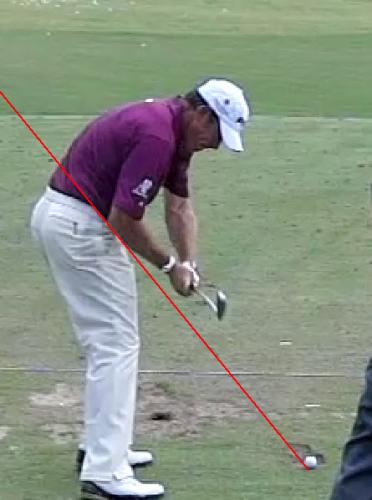
From this view, you can clearly see the club gets a bit too far “over the bottom” of the plane.
*This might be a bit more exaggerated than it really is due to the camera angle being a bit too much pointed at his heels.
You can also see the effect this has on the path of the club.
So what’s causing this? Could it be the ab crunch, loss of lordosis and not much lateral bending?
And this of course causes early right shoulder internal rotation, right arm extension and right wrist flexion. These movements are causing the swing arc to widen prior to impact and therefore the path is significantly altered. In this case a steep downswing can make for a swing path that’s going left.
Next is Phil Mickelson switched to a righty so there’s no confusion.

Given this slightly steep downswing plane, what’s his swing path going to be?
- Straight at target
- Slightly right of target
- Slightly left of target

- Straight at target
- Slightly right of target
- Slightly left of target

- Straight at target
- Slightly right of target
- Slightly left of target
Answer is………
“b” slightly to the right of target.
Late lateral benders like Carl Pettersen and KJ Choi have this similar appearance as Phil. The lateral bend plus late right shoulder external rotation flatten their swing planes after looking steep in the early part of the downswing.

How about Keegan Bradley?
- Straight at target
- Slightly right of target
- Slightly left of target

- Straight at target
- Slightly right of target
- Slightly left of target

- Straight at target
- Slightly right of target
- Slightly left of target
Answer is “b” slightly to the right of target.
Perhaps these are enough examples to show that one can never be sure of path based purely on the plane. Generally accepted rules of the plane do not seem to apply to all swings.
Bottom of the Swing Arc
Many believe that the perfect plane provides the correct “geometry” that will produce solid, clean strikes so you never hit it thin or fat. Well, what if you are casting or flipping it? Wouldn’t this cause the club to bottom out prior to impact and cause fat shots? Yes, and even the pros that are flipping it are making the compensation to slide their upper body toward the target to move the bottom of the swing in front of the ball.
Launch Plane Position and what pros do
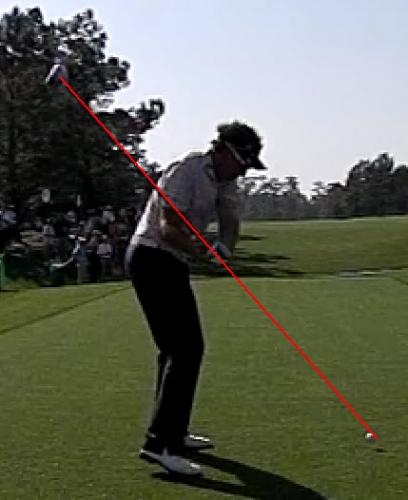
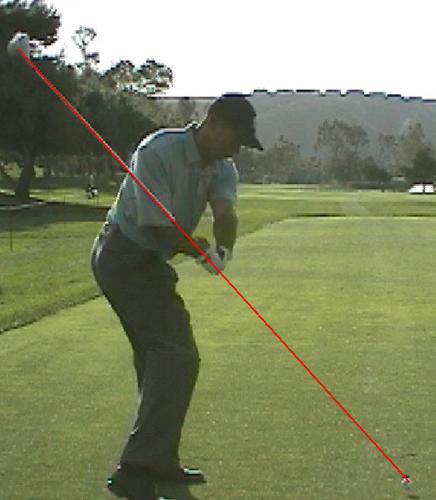
At some point after the start of the downswing, most of the tour players seem to find a launch plane position (I just made that up) where the club somewhat points toward the ball. As we have seen, some are steep while others are flat so this is by no means a universal truth either.
Depending upon their shot shape preference (draw, straight or fade), body rotation, lag amount and release pattern they will swing the club sort of on, under or over the launch plane position. This will set up anatomical positions to hit repeatable shots (typically their release style has evolved or been trained to “match” their launch plane position and resultant swing path otherwise they would not be consistent enough to be on tour).
Amateurs typically cannot find such a launch plane position due to errors in backswing and transition so may be quite a lot of mandatory compensatory moves are required to hit it solid and straight. When even one of those mandatory elements is missing or their release style is a flip/roll (actually “perfect plane + flip/roll release = inconsistent shot pattern), errant shots occur and that is how most golf is played by the amateurs.
Speaking of compensations moves...

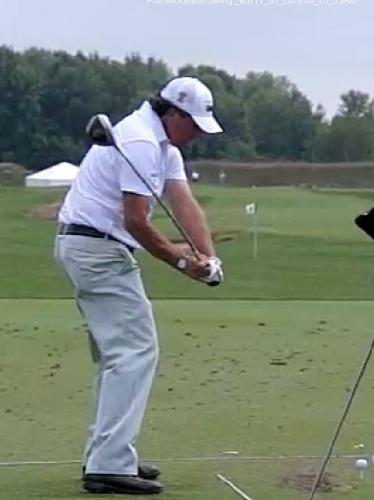
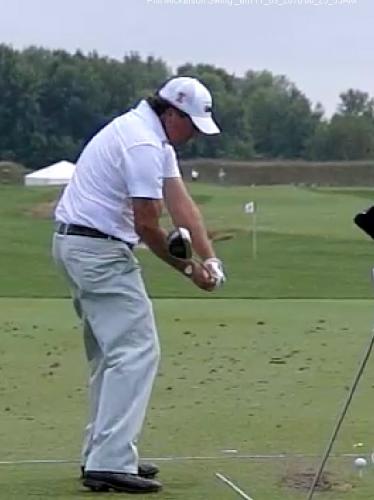
In the first picture, righty Phil doesn’t have a good launch plane position. It’s a bit steep or pointed between the ball and his feet instead of pointing more toward the ball. Then he makes a compensation move (late ER of right shoulder), this opens the clubface later in the downswing (see picture #2 and #3). Perhaps this is the reason he needs to use a fast rolling release to hit it straight?
I shall cover more of these patterns in greater detail in part 2 of the plane.
There is no one perfect swing plane that ensures success. What’s equally important (if not more important) than the plane are the release style, micro movements of the arms/hands/wrists and body movements.
There are tour pros that are swinging on steep planes, flat planes and of course there are many that are steep in some part of the swing while flat in another.
And there is no consensus on path either. Some tour pros are swinging left, some right and some straight at their target. The path typically matches the ball flight. In other words, players hitting fades will be swinging left while players hitting draws are swinging to the right.
Perfect Plane + flip/roll release pattern = military golf
What if an average golfer had the perfect plane yet employed a flip/roll release? His clubface angle at impact can vary far more than the pros from swing to swing since the flip/roller’s clubface is wide open prior to contact and then rapidly shut through impact. They must rely on exquisite timing that not even a tour player could master.
Perfect Plane + flip release = loss of distance
Another situation that is common amongst amateurs is that they use the flip release. Flippers generally have good clubface angle (open-closed) control. What they cannot control well is the loft. If you have the perfect plane but hit it high and short, you probably flip it.
Bottom of the swing arc can change as well. With a flip or flip/roll release the bottom of the swing arc will tend to be behind the ball leading to fat shots. Typically these players will use excessive lower body slide or upper body lunge which will help move the bottom of the swing arc forward or more in front of the ball. But by doing so these players will lose the rotational movements of the body therefore lose swing speed thus lowering distance potential.
Or you could have a plane that is too flat, but due to release pattern, your path could be straight at your target. Isn’t that desirable? Of course you could change your plane so that you’d be perfectly “on plane” but with the same release pattern, now you’d be swinging way left. Hmmmm.
Video problems
With cameras shooting at 30 or only 60 frames per second and viewing from the target line, there is the possibility that you are swinging far more left of target than you think despite having a “perfect plane.” Thus you will probably be locked into the pattern of hitting fades or pull draws.
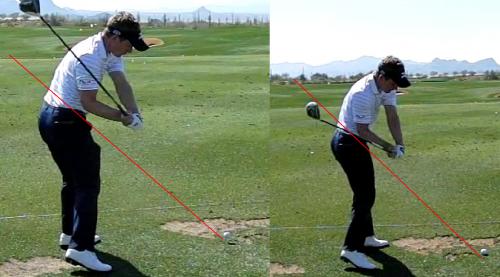
Here’s another video problem. If the camera is positioned too far behind or at the heels (left) or too far in front of the toes, the plane will look remarkably different. So here’s Luke Donald from two incorrect angles to view the plane. The swing on the left looks a bit steep while the swing on the right looks too flat.
Height matters too
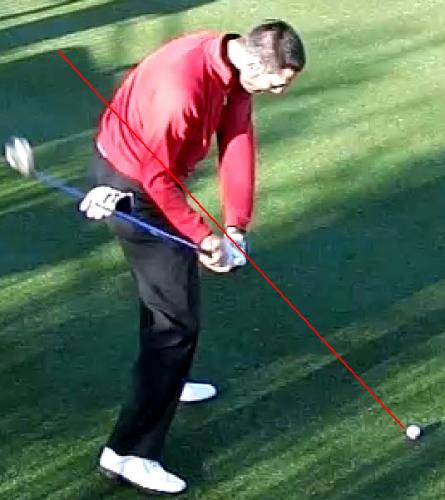
Here’s Quiros shot from around 10 feet above. Wouldn’t this be expected? Looks way flat.
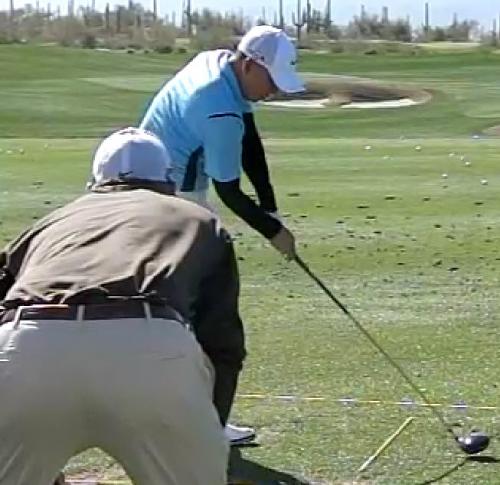
Proper positioning of the height of the planeologist’s eyes requires bending over or squatting.
There’s more planeology to explore next month as we delve into how the hands, wrists, arms and shoulders create movements of the clubface and path in the impact zone that will ultimately determine where the ball will have a tendency to go.

